It's taken a few decades, but South Florida has finally shaken its image as America's retirement home. But before the Magic City became an international center of hipsterism, it really was a place where the elderly came to wile away their golden years near the beach. So perhaps it's no surprise there are plenty of international celebs whose final resting place is the 305.
You've heard about Gianni Versace, Al Capone, and Bob Marley. But here are five famous characters you might not have known were buried in South Florida.
1. Fernando Bujones: One of the greatest American male ballerinas of all time.
A leotard-clad Fernando Bujones gracefully leaps to the music of La Fille Mal Gardée, his balloon sleeves flapping with each jump. Known as one of the greatest American male ballet dancers of his generation, he stole stages around the world.
Though he was born in Miami in 1955, Bujones moved to Havana, Cuba, at 6 years old with his mother, a dancer herself. There, he studied with renowned prima ballerina assoluta Alicia Alonso. Soon after, he received a scholarship from the Fort Foundation and attended the New York City School of Ballet at only 11 years old. Within three years, he outshone his peers, even garnering two offers from George Balanchine to join the New York City Ballet. Both times, Bujones declined.
In 1973, he became a soloist in the American Ballet Theatre’s corps, an achievement that was soon followed by a win at the International Ballet Olympics in Varna, Bulgaria, the next year. Though most of the dance world already knew him, the unexpected victory scored him the title of one of the world’s foremost male dancers — and a promotion to principal dancer at the American Ballet Theatre.
His success was momentarily cut short due to a bitter feud with Mikhail Baryshnikov. Soon after Baryshnikov became the theater's artistic director, Bujones resigned, angry at the castings Baryshnikov chose for him. In the years that followed, Bujones toured the world as a guest artist with the Joffrey Ballet, Moscow’s Bolshoi Ballet, and the Boston Ballet. But once Baryshnikov stepped down, Bujones returned to the American Ballet Theatre.
In 2005, Bujones was diagnosed with lung cancer and died of metastatic melanoma at the age of 50. At the Caballero Rivero Woodlawn Park North Cemetery and Mausoleum near Little Havana, Bujones’ grave commemorates his artistry: "A prince on stage, a prince in life.”
2. Jackie Gleason: Actor best known as Ralph Kramden on The Honeymooners.
Wagging his index finger, a bugged-eyed Jackie Gleason blusters at TV wife Alice Kramden. In his characteristic Brooklyn accent, he shouts, "One of these days, Alice, pow, right in the kisser!"
Born in 1916 and raised in Brooklyn, Gleason grew up the son of Herb, an insurance auditor; and Maisie, a subway attendant. But one night in snowy December, Herb chucked any family photos in which he appeared, packed up, and left. After his father's disappearance, Gleason began hustling pool with a local gang and eventually dropped out of school. Picking up a series of temp jobs, among them stunt driver, carnival barker, and master of ceremonies at a theater, Gleason fell in love with acting.
When he was 19, his mother died of sepsis from a boil on her neck that Gleason had tried to lance. With only 36 cents in his pocket, Gleason packed up everything he owned and headed for Pennsylvania to work as a professional comedian.
Eventually, Gleason worked up to a position at Club 18 in New York, where patrons paid to be insulted. One day, three-time Olympic skater Sonja Henie walked into the club. Gleason handed her an ice cube and said, "OK, now do something." Immediately, he was signed by the president of Warner Bros., Jack Warner, who'd been watching the affair enthusiastically. By 24, Gleason was a movie star, known for his slicked black hair and inflated physical comedy.
In 1949, Gleason landed his first big break, playing the character of an aircraft worker in a radio comedy. Before long, the roller-coaster success landed him his own program, The Jackie Gleason Show, featuring flashy dance numbers and funny monologues. In 1964, he moved the show to Miami Beach, where it was filmed in a studio that's now the Fillmore.
A couple of years later, he became the star of the gritty TV comedy The Honeymooners, on which he played the ambitious and absurd Ralph Kramden opposite a ditzy sewer-worker friend and his sensible wife Alice. The series quickly gained popularity, making Gleason one of the most famous TV icons. At one point, a statue of him was erected in New York's Port Authority Bus Terminal.
After a long career in TV, film, and music, the 71-year old vaudevillian passed away in 1987 from colon cancer, among other medical problems. Entombed in a private mausoleum in Our Lady of Mercy Catholic Cemetery in Doral, Gleason rests under an inscription of his famed catchphrase, "And away we go."
3. Mitzi: The original Flipper.
Splashing and trilling, the world's most famous bottlenose dolphin defends a boy from a predatory shark. Though the 1963 film would catalyze a multibillion-dollar dolphin-captivity business, Flipper stole hearts, with Mitzi the dolphin as its star.
Known as the "Lassie of the Sea," Mitzi was born in 1958 and trained at the Santini Porpoise School, which later became the Dolphin Research Institute. Along with four understudy and stunt dolphins, Mitzi played an injured wild dolphin opposite Luke Halpin and Chuck Connors in the famous movie.
At 14 years old, Mitzi died in 1972 of a heart attack. On her plot on Grassy Key are a life-size dolphin statue and a small plaque commemorating her role as the original Flipper.
4. Anastasio "Tachito" Somoza Debayle: Assassinated former president of Nicaragua.
Near his exile home in Paraguay, Somoza was riding in an unarmored Mercedes-Benz sedan in 1980 with his chauffeur and financial adviser. Suddenly, an RPG slammed into the vehicle, instantly charring its passengers. At 54 years old, the former Nicaraguan president was killed in an assassination known as "Operation Reptile," ending the 43-year Somoza family dynasty in Nicaragua.
Sworn into office in 1967, Somoza, like his father, ruled with an iron fist. Though the nation was uneasy about his presidency, he was reelected in 1974. But by then, the Catholic Church and some human rights groups began criticizing the government, while the leftist rebel Sandinistas quickly gained power throughout the country. Though he tried to violently quash their rise — in part through widespread, brutal human rights abuses supported by the U.S. government — Somoza resigned in 1979 and fled to Miami, allegedly carrying a collection of Nicaragua's national treasures. But when Somoza arrived, he was denied entry by President Jimmy Carter, so he rerouted to Paraguay.
He was eventually buried in Miami at Caballero Rivero Woodlawn Park North Cemetery and Mausoleum.
5. Rocky Marciano: Six-time undefeated heavyweight champion who inspired Rocky.
Known for his iron chin and stamina, Marciano laid a knockout punch to world-ranked boxer Carmine Vingo that was so devastating it left Vingo with a career-ending brain injury.
Born on the south side of Brockton, Massachusetts, to Italian immigrants in 1923, the heavyweight champ began as a baseball player but soon began boxing a stuffed mailbag that hung from a tree in his backyard.
After dropping out of school, Marciano worked a number of odd jobs: a delivery chute man, a ditch digger, and a shoemaker. Eventually, he was drafted to the U.S. Army in 1943, during which he won many amateur boxing tournaments. Once he was discharged, he headed for North Carolina to try out for a Chicago Cubs farm team. After three weeks of playing, he was cut.
Marciano then went all-in on a professional boxing career. As he scored knockout after knockout, the underdog climbed to the top tiers, beating fighting legends Jersey Joe Walcott, Ezzard Charles, and Don Cockell. At his last title bout, Marciano fought Archie Moore and was knocked down in the second round, but he got up on the fourth count. By the ninth round, he knocked Moore out. The following year, Marciano announced retirement, finishing his career at 49-0 with the highest knockout percentage — a hefty 87.76 — of any heavyweight champion in history. Marciano would eventually inspire Sylvester Stallone's Rocky Balboa in the classic films.
In 1969, the night before his 46th birthday, Marciano died when a Cessna taking him to Iowa crashed. He was entombed in a crypt at Forest Lawn Memorial Gardens Central in Fort Lauderdale, where his wife joined him five years later.
[
{
"name": "Air - MediumRectangle - Inline Content - Mobile Display Size",
"component": "19274298",
"insertPoint": "2",
"requiredCountToDisplay": "2"
},{
"name": "Editor Picks",
"component": "17482312",
"insertPoint": "4",
"requiredCountToDisplay": "1"
},{
"name": "Inline Links",
"component": "18711090",
"insertPoint": "8th",
"startingPoint": 8,
"requiredCountToDisplay": "7",
"maxInsertions": 25
},{
"name": "Air - MediumRectangle - Combo - Inline Content",
"component": "17482310",
"insertPoint": "8th",
"startingPoint": 8,
"requiredCountToDisplay": "7",
"maxInsertions": 25
},{
"name": "Inline Links",
"component": "18711090",
"insertPoint": "8th",
"startingPoint": 12,
"requiredCountToDisplay": "11",
"maxInsertions": 25
},{
"name": "Air - Leaderboard Tower - Combo - Inline Content",
"component": "17482313",
"insertPoint": "8th",
"startingPoint": 12,
"requiredCountToDisplay": "11",
"maxInsertions": 25
}
]

















